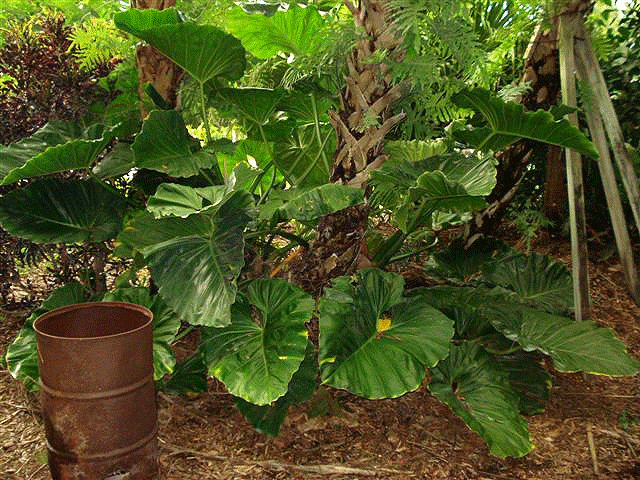![]()
Aroids and other genera in the Collection
Take the Tour Now?
Orchids
The
Exotic Rainforest
Plants in
the Exotic Rainforest Collection
Images on this website are copyright protected. Contact us before attempting to reuse.
In depth information on how to grow Philodendron species, Click this Link
Within our collection we have many species of Philodendron. If you are seeking other photos, click this link
Philodendron
giganteum Schott
Other Large
Philodendron species:
The photo at the top of this page
is Copyright 2008, Buddy Poulsen, Naples, FL. Please note the size
of each leaf in comparison the the 208 liter (55 gallon) drum!
In 2000 Janice and I often
visited an exotic plant nursery near the Everglades southwest of
Miami. They sold primarily orchids but sometimes would have very
interesting aroids and bromeliads. One day they had a large leaf
Philodendron that almost begged to be bought! The
grower had a book
to show just how large this "Giant
Philodendron" as
it was tagged was supposed
to grow. Behind a leaf, that appeared to be close to 1.5 meters
(almost 5 feet tall),
a woman stood peeking out to the side with her body mostly
hidden. I love plants with big leaves and that photo made a sucker
out of me! I bought it!
I later learned the seller likely had the wrong name on
the plant since Philodendron giganteum does not always get quite that
large and, once grown, doesn't look like the plant in the photo. The maximum leaf size for P. giganteum from
Described to science in 1856, Philodendron
giganteum ranges from the Greater Antilles including Puerto Rico
throughout the Lesser Antilles into the northeastern portion of
Venezuela. The species is either terrestrial or epipetric
which simply means it is capable of growing on rocks. The
species is characterized by a bright red spathe tube, short
internodes, persistent cataphyll fibers and a petiole that may be
longer than the leaf blade. The cataphyll is the portion of
the plant that surrounds and protects a new leaf blade when it is
first developing and beginning to emerge. Specimens found in
the Lesser Antilles may have a spathe tube that is less red and
partially green on the outside.
Some texts indicate Philodendron giganteum is
exclusively found on the Caribbean island of Trinidad. But according to the USDA as
well as information published by botanist Dr. Tom Croat of the
Missouri Botanical Garden, Philodendron giganteum is found in the Caribbean islands of Dominica, Guadeloupe,
Martinique, Montserrat, the Netherlands Antilles islands of Saba
and St. Eustatius, Puerto Rico, St. Kitts, St. Vincent, Trinidad and
Tobago, the Virgin Islands and in northeastern South America.
The spathe of Philodendron
giganteum which is shaped like a hood is a delicate white
on the inside but bright red on the outside.
As far as I can find the plant is a self header and does not
climb. It will tolerate quite a bit of shade but will grow faster
in semi-bright filtered light. We give it well draining soil and
keep the soil damp at all times. The plant in the photo (above
right) is a
replacement for the one I bought in 2000. When we moved the
collection to Arkansas in 2001 that plant did o't survive the first
winter in our temporary greenhouse. This specimen had leaves averaging 13 inches (33cm) after one year
of growth. The species often commonly available since it is
grown from tissue cultures (cloned) by a lab in Central Florida.
However, tisuue culture often alters the plants appearance.
Philodendron species,
especially hybrid forms, are
known to be variable and not every leaf of every specimen
will always appear the same. This link explains in
non-technical language the science of natural variation and
morphogenesis.
Want to learn more
about aroids?
Specimens may be available
from Natural Selections Exotics
or Brian's Botanicals
http://www.briansbotanicals.net/

Click to see Philodendron maximum
K. Krause
Click to see Philodendron gigas
Croat scientific information available is 190cm x 96cm (76
inches by 38 inches). For a while I thought the plant in
that photo was very likely one from Ecuador known scientifically as
Philodendron maximum, an appropriate name for a Philodendron with
large leaves. I've since learned
Philodendron maximum rarely
reaches more than 165cm (5.5 feet). And there is a third large
Philodendron from Panama
known as
Philodendron gigas which
can grow to 125cm (4.1 feet) in length. But recently
someone sent me a copy of that old book, the Exotic Plant Manual.
And the plant in the photo was tagged Philodendron
speciosum from southeastern
Brazil and wasn't quite as large as my memory had convinced me it
should have been. And as it turned out, P. speciosum
looks little like Philodendron giganteum
which was the plant I had been sold.
The specimen above (right) is a juvenile specimen of
Philodendron
giganteum.
scientific information available is 190cm x 96cm (76
inches by 38 inches). For a while I thought the plant in
that photo was very likely one from Ecuador known scientifically as
Philodendron maximum, an appropriate name for a Philodendron with
large leaves. I've since learned
Philodendron maximum rarely
reaches more than 165cm (5.5 feet). And there is a third large
Philodendron from Panama
known as
Philodendron gigas which
can grow to 125cm (4.1 feet) in length. But recently
someone sent me a copy of that old book, the Exotic Plant Manual.
And the plant in the photo was tagged Philodendron
speciosum from southeastern
Brazil and wasn't quite as large as my memory had convinced me it
should have been. And as it turned out, P. speciosum
looks little like Philodendron giganteum
which was the plant I had been sold.
The specimen above (right) is a juvenile specimen of
Philodendron
giganteum.
Click
here.
Join the
International Aroid Society:
http://www.exoticrainforest.com/Join%20IAS.html
![]()
